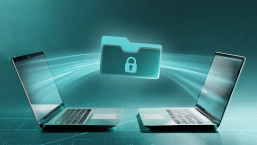With record-setting temperatures this summer, many people will be taking their laptops, tablets and smartphones with them to cooler climes in order to stay cool while staying online. Increased device mobility means increased risk, though, and this article will give you some tips on how to more safely navigate the mall, library, coffee shop or wherever it is you go to chill out and relax.
Safety While On the Go…
Whether you are traveling with your laptop or tablet in a car, bus or train or carrying it, it is a good idea to go for the inconspicuous look. Nothing says “expensive device worth stealing” like an expensive backpack, bag, or case. A proper and secure container for your computer does not have to be expensive, and in many cases, a regular old-but-serviceable backpack or bag, coupled with a foam sleeve for your device, is just the thing to ward off unwanted attention.
If you are going to be leaving your device in a car for a while, place it in the trunk, underneath a seat or in some location where it is not visible from outside the vehicle (if you're going to put something in the trunk, try to do so before you arrive at your destination). If you are on mass transit or even just walking in public, be sure to always keep at least one shoulder looped or handle firmly held, in order to prevent a twenty first century-style purse snatching.
Also, make sure that both your device and your bag have your name, phone number and possibly an email address on them in multiple locations. In the event you accidentally left your device somewhere, that can help get it returned. Laptops can be labeled on the bottom, inside battery compartments or doors for memory or storage expansion and so forth.
…and Once You’ve Arrived
Many laptop computers have a security slot in them for connecting a laptop cable lock. If you are going to be in one location for a long time, such as a library or coffee shop, consider using one of these security devices to secure your computer to a table or desk. It will prevent a casual, inconspicuous “grab and walk-away” type theft.
How to Step Away Safely
If possible, take advantage of the “Buddy System:” Ask someone who is sitting near you to keep an eye on your computer if you have to step away for a more than a few seconds and do not wish to take your device with you. You can also repeat the process for them as well, keeping an eye on things while they step away. This does, of course, depend upon the context of where you are: It may be far safer to do this at the local coffee shop than at, say, your local flea market.
Naturally, if you do step away from your device, you will want to lock its screen. For smartphones and tablets, a PIN might be sufficient, but care should be taken to avoid selecting a bad passcode. Even if a thief doesn’t take your device, there still might be some value for someone to see what’s on your screen. Here’s a true story of something that recently happened to me:
A few weeks ago, I was stuck in commute traffic from Los Angeles to San Diego and decided to wait it out by getting off of the road at Mission Viejo and getting a latté at a handily-located Starbucks. As I sat in the coffee shop, I was amazed to see someone leave a spreadsheet open on their laptop in plain view. In the two or three minutes the owner was away from their computer, I could have saved off a copy to my USB flash drive, altered it, or even taken a photo of it. For all I know, I may have even been even been able to install software on to the computer.
I did none of these things, of course, but it does provide an important reminder about physical security, especially outside of places you do not control access to, such as your home or office.
The Perils of Free Wi-Fi
Many coffee shops, bookstores, libraries and restaurants offer free Wi-Fi for visitors. But just because it is free does not necessarily mean you should take advantage of it. It is possible that someone might be monitoring and capturing network traffic going through the “free” Wi-Fi connection, for reasons ranging from questionable to illegal, (depending upon your jurisdiction, such as (injecting targeted advertising into web pages to the outright malevolent, such as stealing credentials for email, financial institutions and so forth.
If you must use the free Wi-Fi service, do not access log in to any sites for which you need a password, such as your email, bank or online shops. It is more secure to tether your tablet or laptop to your smartphone and make use of its data connection, or use a portable hotspot. While such connections may not be free, they do have the advantage of being far less likely to be intercepted.
A Reminder About Updates
If you do choose to make use of Wi-Fi, it is a good idea to make sure your device’s operating system and anti-malware software are up-to-date. Take a few minutes to manually check for updates and install them before you leave home or the office. If you have pending updates for frequently-exploited software like Oracle Java, Adobe Flash or Reader, you should allow those to install as well.
If you are going to be using your mobile computing device while out and about, it is a good idea to have some kind of anti-theft software on your device, whether it be a laptop, tablet or smartphone. This may be a basic feature provided by the device manufacturer or operating system developer, or it may be something that you install from a trusted third-party, like ESET’s anti-theft technologies for Android devices and Windows computers.
Conclusion
Regardless of where you go to escape the heat, it’s prudent to keep your cool. If the device is hot from being in the car when finally get to your corner of the coffee shop, let it sit for a while to get closer to room temperature. And, if you notice the device becoming hot, or the fan running at full speed all the time, it is probably a good idea to shut down and wait until you are in a cooler location before turning the device back on. (Tip: many laptops have cooling vents on the bottom, so running them on picnic blankets, pillows, or other soft surfaces is not advisable.)
Likewise, do not eat or drink around your device. Even if the keyboard is water-resistant, there’s always the possibility some liquid will go someplace it should not and cause expensive, out-of-warranty damage.
Lastly, if you are in a location where you don’t feel comfortable using your device for whatever reason, don’t take it out and use it. Wait until you are in some place you feel safe before using it, even if that means going back home or to the office.
Many of the steps for protecting your devices while away for a few hours parallel those used when traveling. If you are planning on being away for a more extended period, you may find the following articles of interest:
- Security Never Takes a Holiday: 5 Tips for Cybersecurity on Vacation
- 11 Tips for Protecting Your Data While You Travel
Distinguished Researcher
Do you regularly use a laptop, tablet or smartphone in public? If so, what steps have you come up with to stay secure? Let us know, below!




